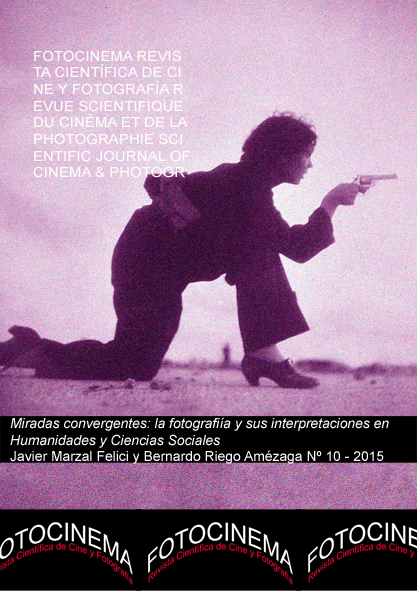Testimoniando con imágenes. La fotografía en el estudio de la historia
DOI:
https://doi.org/10.24310/Fotocinema.2015.v0i10.5978Abstract
Resumen:La fotografía es un interesante soporte que puede estudiarse desde distintas disciplinas debido a su propia naturaleza. En el caso de la Historia, se puede emplear como objeto y como instrumento de análisis, siendo esta segunda opción la que vamos a abordar en el artículo que se presenta.
Desde esta perspectiva, el historiador tiene entre sus manos un contenedor de memoria que, por su capacidad para concentrar en un solo instante espacio y tiempo, se convierte en una herramienta con grandes posibilidades para acercar los sucesos y acontecimientos pretéritos. Para ello, debe tener en cuenta sus características y que lo capturado por la cámara es una (re)presentación de la realidad, es decir, una de las muchas posibilidades que podrían haber sido registradas por el fotógrafo.
Partiendo de la idea de que la fotografía es un espejo deformador de realidades y que su análisis debe realizarse desde la perspectiva que nos ofrece la transdisciplinariedad, nos aproximaremos a su relación con la Historia y cómo debe afrontarse su estudio, incluidas las limitaciones, para que la “segunda realidad”, que es una instantánea, se pueda emplear como documento de memoria.
Abstract:
Photography is an interesting support that can be studied from different disciplines because of its inner nature. In the case of History, Photography can be used both as an object and as an analysis tool. This paper deals with the second option.
From the perspective of Photography as an analysis tool, historians have a rich store of memory that becomes a powerful tool to approach past events because of its capacity to concentrate on just one instant space and time. To do so, two things must be taken into account: its characteristics and the fact that photography is a (re)presentation of reality, just one of the many options that can be captured by the photographer.
Photography is a distorting mirror of realities that must be analyzed from the perspective we get considering the different fields involved. To be able to use the “second reality” which is a snapshot as a source, we should approach its relationship with History and the way its study must be confronted.
Palabras clave:
Fotografía; historia; memoria; transdisciplinariedad; (re)presentación; lectura visual.
Keywords:
Photography; History; Memory; Transdisciplinarity; (Re)presentation; Visual ReadingDownloads
Metrics
Publication Facts
Reviewer profiles N/A
Author statements
Indexed in
-
—
- Academic society
- N/A
- Publisher
- Universidad de Málaga
Downloads
Published
How to Cite
Issue
Section
License
All contents published in Fotocinema Revista científica de cine y fotografía are protected under the Creative Commons Attribution-NonCommercial-ShareAlike 4.0 International (CC BY-NC-SA 4.0) license. All about this license is available in the following link: <http://creativecommons.org/licenses/by-nc-sa/4.0>
Users can copy, use, redistribute, share and exhibit publicly as long as:
- The original source and authorship of the material are cited (Journal, Publisher and URL of the work).
- It is not used for comercial purposes.
- The existence of the license and its especifications are mentioned.
There are two sets of authors’ rights: moral and property rights. Moral rights are perpetual prerogatives, unrenounceable, not-transferable, unalienable, imprescriptible and inembargable. According to authors’ rights legislation, Fotocinema. Revista científica de cine y fotografía recognizes and respects authors moral rights, as well as the ownership of property rights, which will be transferred to University of Malaga in open access. The property rights are referred to the benefits that are gained by the use or the dissemination of works. Fotocinema. Revista científica de cine y fotografía is published in an open access form and it is exclusively licenced by any means for doing or authorising distribution, dissemination, reproduction, , adaptation, translation or arrangement of works.
Authors are responsable for obtaining the necessary permission to use copyrighted images.














13.png)



